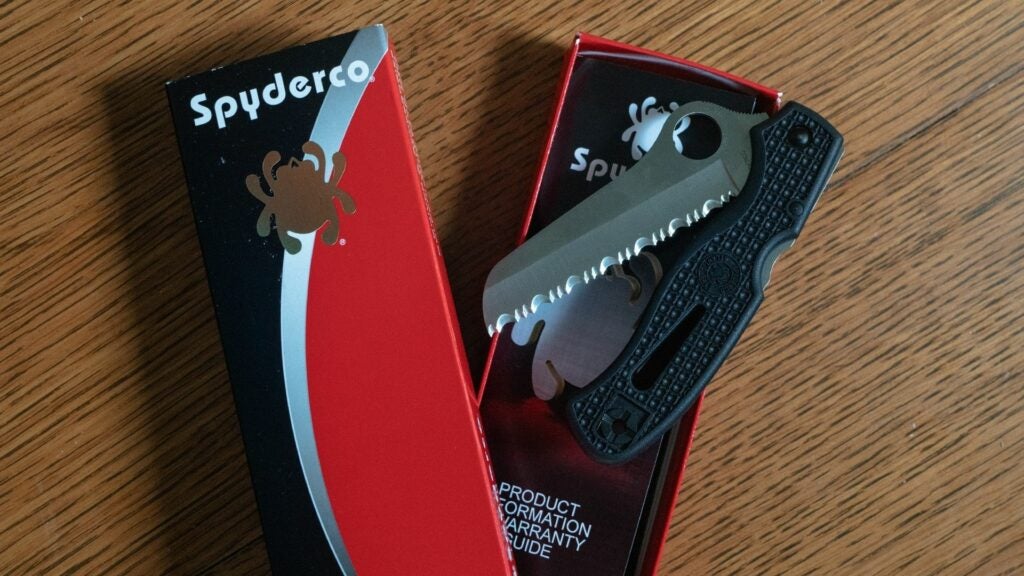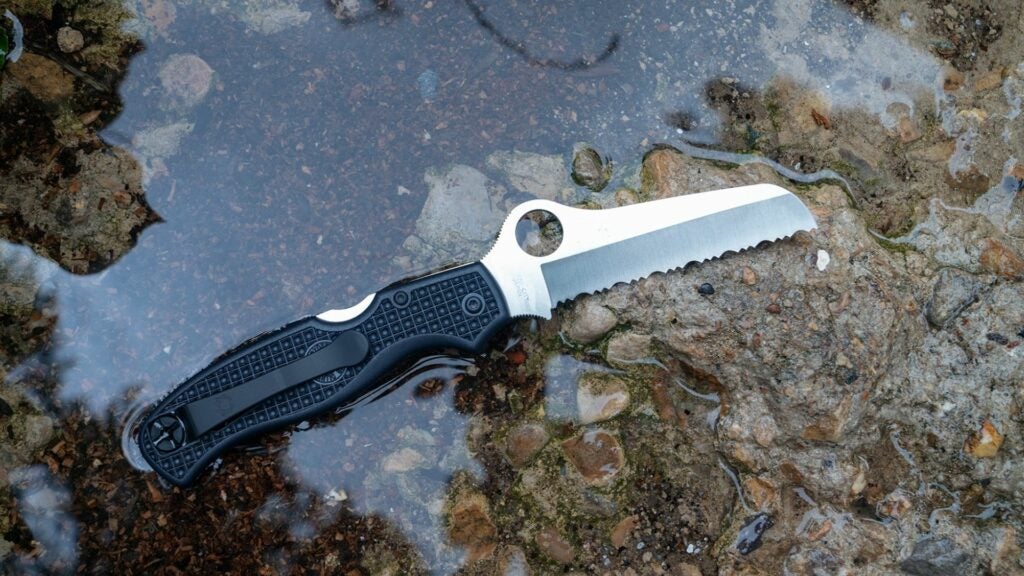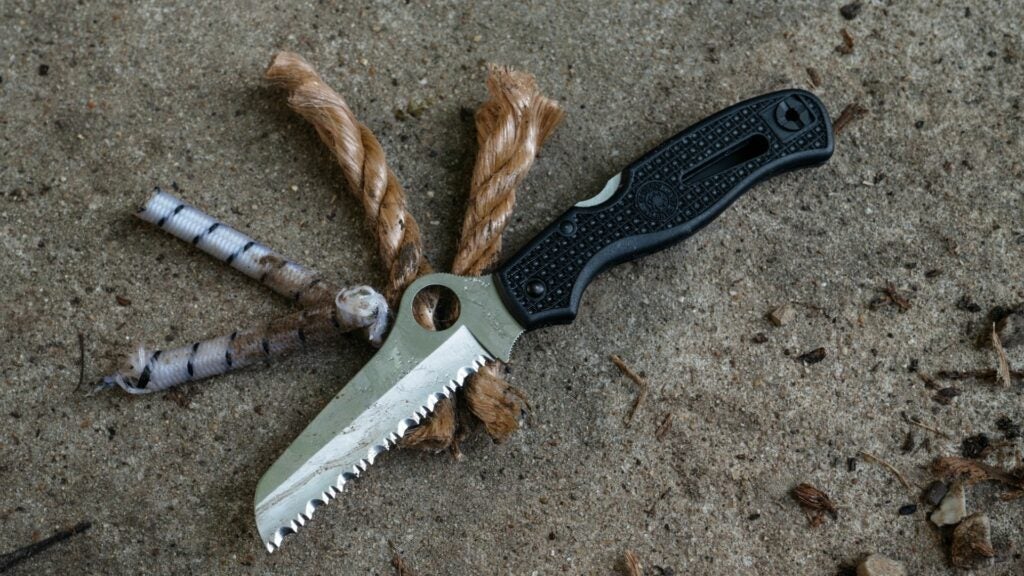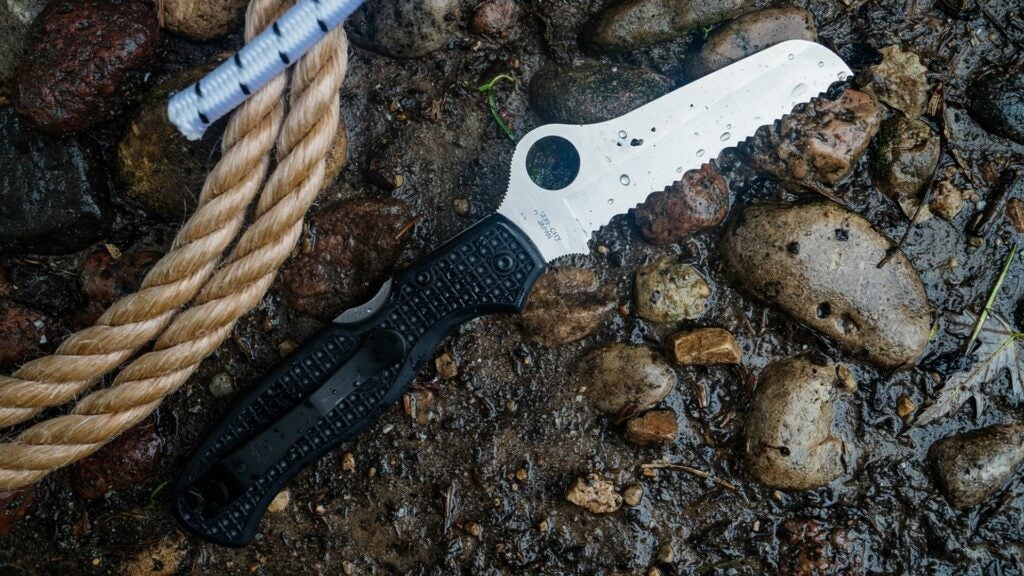My fellow Task & Purpose gear testers and I have put a bunch of EDC and tactical knives to the test lately, and there are more where those came from. But as much as I love a versatile piece of gear that I can carry anywhere, I also appreciate equipment that’s purpose-built to do one thing exceptionally well.
Leave it to the people at Spyderco to build something so incredibly niche that it feels like it was made just for you. In that case of the Atlantic Salt, that comes in the form of a knife designed for life on the high seas. It doesn’t matter if you’re in the Navy or Coast Guard; on a merchant ship or fishing vessel; you need to be equipped to untangle yourself from a sticky situation in a hurry. Hell, even roughnecks need gear that can withstand the various hazards of life on the open sea. Being able to slice through dirty rope and netting isn’t just efficient, it can mean the difference between life and death.
Boat knives tend to come in two varieties: those that are cheap enough to be disposable, and those that are built to last. The cheap stuff can be picked up for as little as $10, but don’t plan on keeping it very long. High-end alternatives start around $50 for a basic dive knife and go up in price as you gain features and more sophisticated steel alloys.
If the Spyderco Atlantic Salt’s price tag of just under $150 seems like a lot for a knife with such a narrow focus, it’s probably because you haven’t been at sea enough to blow through knives faster than MRE sporks. In addition to the salty air, seawater that makes its way onto a knife’s blade or into a folding mechanism can compromise stainless steel surprisingly quickly. If I made my living offshore (like many of you do), I’d damn sure want to have a knife I could rely on. That sounds like a reason for a product test if I’ve ever heard one.
Blade lenght: 3.687 in
Weight: 2.75 oz
Material: H-1 steel (blade), FRN (handle)
Unboxing
If you’ve ever bought a knife from Spyderco, you can imagine what unboxing my Atlantic salt was like. Packaging was a no-frills affair; just a cardstock box and some bubble wrap. One thing Spyderco does right is the product literature that comes with every knife. I was able to learn about the Salt series’ purpose, history, design, and materials without even consulting Spyderco’s website. That’s a nice touch.

Like the Spyderco Endura 4 and Delica 4, the Atlantic Salt uses an incredibly durable fiberglass-reinforced nylon handle that keeps weight to a paltry 2.75 ounces. At that weight, the knife just about vanished the second I put it in my pocket. I have to imagine that people who have to deal with heavy rain suits and rubber boots appreciate shedding ounces when they can. The handle measures 4.625 inches long. With the blade extended, the knife has a total length of 8.188 inches.
Everything about the Atlantic Salt’s blade was designed with nautical use in mind. Deckhands don’t need to stab things very often, but they do work in slippery conditions and often wear thick gloves, so this knife got a rounded tip that makes it less likely to become a puncture risk if it were to be dropped. The edge is fully serrated to make quick work of thick ropes and nets, even when they’re gummed up with salt, sand, and general oceanic nastiness.
Most importantly, the Atlantic Salt prioritizes resistance to rust and corrosion. How well a given type of steel resists corrosion basically comes down to how much carbon is present in the alloy. Spyderco’s engineers know this, and they opted to omit carbon from Salt series blades altogether. Instead, they chose H-1 steel, an alloy that uses nitrogen instead of carbon.
Feel free to read all about the science behind H-1 steel if you’re into that kind of thing. Otherwise, just know that it’s a relatively soft steel that gives up a little in terms of edge retention to be relatively flexible and damn near impervious to corrosion.
How we tested the Spyderco Atlantic Salt

If a knife has the word “salt” in the name, obviously I have to incorporate a salt test in my review. I’ve soaked knives and multitools in salt water and let them air-dry before, but it seemed like the Atlantic Salt deserved a little more than that. Instead, I increased the usual routine to three rounds of soaking for one hour and drying for 30 minutes with no maintenance in between.
For this test, I always use a mix that’s so salty I almost feel bad subjecting anything to it. This time around, it felt more like an exercise in futility. An hour in, and the blade was spotless. Air drying left only water spots. Hours two and three yielded the same results. The opening mechanism and lock were so simple and overbuilt that they, too, were unfazed.
Since knives aren’t the only thing that takes a beating at sea, I devised a more challenging rope-cutting test for the Atlantic Salt, too. First, I purchased a few feet of the thickest rope my local hardware store had: half-inch twisted polypropylene. Heavy-duty bungee cord looked relevant, so I got some for the hell of it. Next, I soaked both in saltwater and rolled them in sand to get the material nice and gritty. This might sound like a gratuitous torture test, but it’s remarkably close to the kind of thing knives have to tackle every day on vessels around the world.
My devious plot to gum up the Atlantic Salt was to no avail. The serrated blade easily ripped through the rope and bungee cord, sending sand, salt, and water flying. I made a few more cuts for good measure, including dry rope and bungee cord. The knife performed admirably each time.
What we like about the Spyderco Atlantic Salt

It’s important to look at the details when considering your next knife purchase, and there’s a lot to like about the Atlantic Salt. The famous thumb-hole is a great alternative to studs and makes opening this knife much easier with gloves on. I tried it with floppy work gloves, and it was a lot easier than searching for a tiny thumb stud or flipper mechanism. The reversible pocket clip is handy for lefties, but it’s also nice for anyone who wants to carry multiple tools in different pockets. Its mounting point is hollow, providing a convenient place to attach a dummy cord. The back lock is incredibly strong and easy to use with or without gloves.
Spyderco set out to create a knife that could resist the corrosive conditions experienced at sea, and they knocked that goal out of the park. I created the most rust-friendly test I could think of and the Atlantic Salt shook it off like it was a gentle wipe with a dry cloth. Short of submerging this knife in acid, I think you’d be hard-pressed to damage it.
Spyderco’s build quality speaks for itself, but you can also read all about it thanks to a devoted online fanbase. Every Spyderco knife I’ve handled made it clear that the company values functionality above all else. From the fiberglass-reinforced nylon handles to the carefully selected alloy used in each blade, Spyderco knives are built to perform. The styling may seem unconventional to some (myself included), but I’d have no reservations about packing a Spyderco for a fishing trip, backcountry adventure, or maritime deployment.
What we don’t like about the Spyderco Atlantic Salt

I’ve established that H-1 steel is fantastic at performing in salty, corrosive environments without being damaged, but it’s not without drawbacks. The main criticism of H-1 is its reduced edge retention compared to many other types of knife steel. Replacing carbon with nitrogen protects against rust, but it also makes the steel significantly softer. The good news is that softer blades are less brittle (and therefore less prone to breaking) than traditional alloys, but they also wear faster. That shouldn’t be a deal-breaker for the Atlantic Salt since its primary purpose will be cutting soft materials like rope, but it’s worth considering.
Another way of thinking about the Atlantic Salt’s specialization is niche functionality. The better a tool becomes at one task, the less capable it is elsewhere. Take the rounded tip and full-length serration, for example. Those features wouldn’t be as useful as a pointed blade and straight edge in the majority of situations that require a knife, so consider the Atlantic Salt a focused addition to your knife collection rather than a viable EDC option. I’d also prefer to have this particular knife with the available yellow handle since I’m more likely to need to find it on a cluttered boat deck than conceal it in a tactical environment.
Verdict
Maybe this gear review shouldn’t have surprised me, but I’ve seen stainless steel rust like iron before. I genuinely pushed the Atlantic Salt harder than other gear I’ve reviewed and it still looks and functions like new.
The Atlantic Salt isn’t for everyone or every purpose. It’s pricey and the fully serrated blade isn’t nearly as versatile as a plain or combined edge. There are other knives I own for cooking, daily tasks, and tactical use. But if I ever set foot on an ocean-going vessel again, you can bet your ass this will be the one in my pocket.
Saved rounds
I’m a big fan of owning tools for jobs. I have separate folding knives for campsite cooking and working in the garage. I own skis that are useless anywhere but a hard-packed giant slalom course. There’s just something satisfying about using a tool that’s totally in its element. Is the Atlantic Salt for everyone? No, but I’m considering planning a fishing trip just so I have an excuse to use it more.
[embedded content]
FAQs about the Spyderco Atlantic Salt
More questions? Here’s Task & Purpose’s additional brief.
Q: How much does the Spyderco Atlantic Salt cost?
A: Spyderco lists the Atlantic Salt at an MSRP of $149. I don’t want to pay MSRP if I can help it, so I dug up a discount price of $104 on Amazon.
Q: Are Spyderco knives worth the money?
A: Spyderco knives are often on the higher end of the price spectrum, and there are basically two reasons for that. Spyderco uses high-quality materials that aren’t cheap to produce or turn into finished products. The company’s knives are also manufactured in Japan, where commercial real estate and skilled labor come at a hefty premium.
The result is a line of knives that have earned almost cult-like loyalty from customers around the world. Yes, you can expect to pay more than you would for a Kershaw, SOG, or Civivi, but your money will be well-spent.
Q: Is the H-1 blade actually better than other kinds of stainless steel?
A: All stainless steel is not created equal. I’ve been able to make some stainless tools to rust in just an hour––hence my go-to salt bath test. Spyderco’s H-1 steel is noteworthy. I tripled the severity of my usual test and didn’t see a spec of rust or corrosion.
Q: Wouldn’t this level of durability make the Atlantic Salt a good EDC knife?
A: Maybe, but only if you spend every day on or around saltwater. Remember that the incredible corrosion resistance of H-1 steel comes at the price of edge retention. Fully serrated blades are also less versatile than straight edges or combination edges, so there are fewer situations when the Atlantic Salt would be an ideal tool. The same goes for the rounded tip; it’s great to use with wet hands on a pitching deck, but not when you need to pierce something or make a precise incision. The Atlantic Salt is a specialized piece of gear, not a do-it-all folding knife.
Q: What’s up with that funky hole in the blade?
A: I have to assume this question will come up any time I review a Spyderco knife, and that’s fair. The thumb hole is an unconventional design feature, but I’ve grown to prefer it over thumb studs in most cases. It’s streamlined, easy to use, and cuts down on unnecessary weight. Those are all good things in my book.
We’re here to be expert operators in everything How-To related. Use us, compliment us, tell us we’ve gone full FUBAR. Comment below and let’s talk! You can also shout at us on Twitter or Instagram.
Scott Murdock is a Marine Corps veteran and contributor to Task & Purpose. He’s selflessly committed himself to experience the best gear, gadgets, stories, and alcoholic beverages in the service of you, the reader.
Task & Purpose and its partners may earn a commission if you purchase a product through one of our links. Learn more about our product review process.
